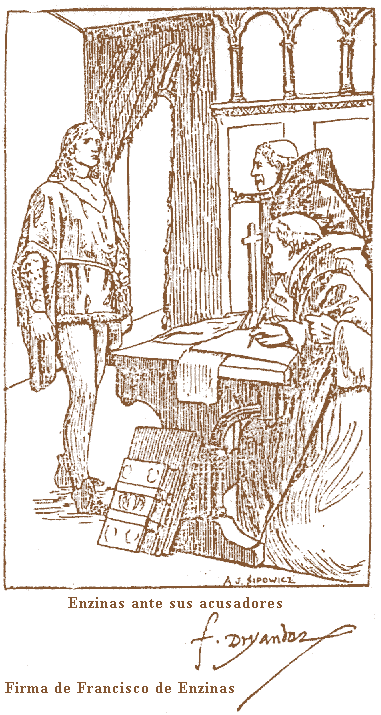The New Testament of Francisco de Enzinas |
|||||
|
|
THE NEW TESTAMENT OF FRANCISCO DE ENZINAS The first complete New Testament translation of the Holy Scriptures into Spanish was the work of Francisco de Enzinas, published in 1543. Enzinas was born in Burgos in 1520. He studied with his brother Jaime at the University of Alcala where the noted scholar Pedro de Leemes taught them in the studies of the Holy Scriptures. In 1540 he moved to the university of Lovaina, where he ended his studies, and where it appears he was influenced by the ideas of the Reformers. His Protestant brother Jaime moved to Paris in 1541 and then to Rome in 1546 where he was arrested by the Inquisition and burned at the stake as one of the first martyrs of the Reformation in Italy. Not in agreement with the doctrines of Roman Catholicism, and fearing for his life, Francisco de Enzinas moved to Wittemberg, Germany, and enrolled in the University there on October 27, 1541. Theodore Vitus, a preacher in Nuremburg said of Enzinas, a Spaniard...a wise man, serious and gifted with a rare virtue, who shows a philosophical zeal in every task In Wittenburg, Enzinas stayed in the home of the famous Melanchton, who encouraged him to translate the New Testament into Castilian. Enzinas agreed to undertake the job, and using Greek manuscripts for his project, he finished after just 18 months of tedious work. Having completed his goal, he went to Lovaina, where he presented his work to the theologians of the city. They counseled him not to publish the work, stating, ...From the Bible has been born all the heresies in Germany and the Low Countries [of Spanish domain] being a pretext for the simple and idiotic people to give themselves to vain interpretations and dreams, rejecting the canons and decrees of the [Catholic] Church. Unswayed by their warning, Enzinas traveled to Antwerp to print his version. On the title page, he desired it should read: El Nuevo Testamento, o La Nueva Alianza de Nuestro Redemptor y solo Salvador Jesucristo. (Translation: The New Testament, or the New Alliance of our Redeemer and only Saviour Jesus Christ.). However, a Dominican priest, who wasnt against the translation of the scriptures into Spanish, warned him that the words alianza and solo Salvador sounded too Lutheran and would make his version suspect to the Inquisition. For this reason he changed it to read only: El Nuevo Testamento de nuestro Redemptor y Salvador Jesu Christo. After publication, the count of Antwerp received an order from Emperor Carlos V to put a stop to the circulation of all Protestant printed materials, including Enzinas New Testament. Enzinas in his zeal then went directly before the Emperor in Brussels to defend his work, and asked if he could distribute it if he included a dedication in the work to the Emperor himself. Intrigued the Emperor asked, What book do you want to dedicate to me? Enzinas responded, Lord, a part of the Sacred Scriptures we call the New Testament, faithfully translated by me into Castilian: in which is contained the principal of the Gospel history and the writings of the apostles. I desire your majesty as defender of religion, to judge and carefully examine my work, and I humbly entreat that the work, approved by your Majesty, would be recommended to the Christian people by your Imperial Authority. The Emperor retorted, Are you the author of this work? Enzinas replied, The Holy Spirit is the author: inspired by Him, some holy men wrote with common intelligence these oracles of salvation and redemption in the Greek language; I am only a faithful servant and weak organ, that has translated this work into the Castilian tongue. The Emperor questioned, In Castilian? To the which Enzinas answered, In our Castilian tongue, and I again entreat you that you be its patron and defender, according to your clemency. Be it as you please, that nothing suspicious [be found] in this book. Nothing that proceeds from the word of God should be suspicious to Christians. May your will be done, if the work is such as you and the Bishop affirm. The Emperor didnt seem too interested in the work, as he gave it to his confessor Pedro de Soto for examination, who demanded Enzinas to abandon the project and cut off all ties to the Lutheran heretics in Germany. Enzinas was then immediately led in chains directly to jail where he passed fourteen months in the company of other accused Lutherans. In February of 1545 Enzinas escaped, and fled to Antwerp, where he lodged with Melanchton once again. In 1546, he traveled to Strasburg, Zurich, and then Basel, where he settled down and published his History of the Death of Juan Diaz, and a critique of the Council of Trent. Enzinas later married in Strasburg to Margaret Elter, and together they moved to England, where he was well received by archbishop Cranmer, who put him to work at the University of Cambridge as a Greek professor. His alias there was Francisco Dryander. In 1552, he went to Geneva to meet with John Calvin, with whom he corresponded for many years. On his journey back to England, he died from the plague on the 30th of December of the same year. An interesting note about the Enzinas version is that it does not read Verbo in John 1:1, rather Palabra as all Protestant versions do. This will be important to note later on. Click here to...
|
The title page the 1543 New Testament of Francisco de Enzinas, aka, Francisco Dryander. Francisco de Enzinas in front of his accusers. |
|||
|
|
|||||
|
|
|||||
|
|
|||||
|
|
|||||

